Results
-
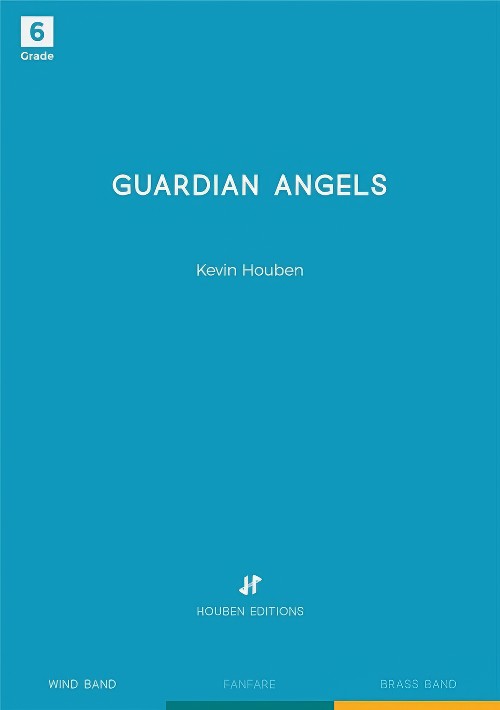 £159.99
£159.99Guardian Angels (Concert Band - Score and Parts) - Houben, Kevin
Guardian Angels gives a musical expression to the legend of Reverend Louis Henri Bahler referring to the use of Psalm 34. North-west Veluwe and in particular Oldebroek (The Netherlands) has a very rich religious tradition which is demonstrated by its monumental churches. They tell the story of a stirring history in which Reverend Bahler played a crucial role. Inspired by his arrival as a pastor in 1870 in the neighbouring Oosterwolde, two big religious communities came into existence with their characteristic churches but this rivalry also resulted in great social unrest. This composition reflects on this striking personality and in particular on the story of the Angel Guard. 'One evening Reverend Bahler has given a sermon in Oldebroek and he walks over the Church path through the pastures to Oosterwolde. On this dark and stormy evening Bahler's opponents are waiting for the pastor in ambush. They want to drown him in a watercourse near the Church path but abandon their plan because Bahler is accompanied by two men. The next day it comes to an encounter between Bahler and his opponents. They repent their, fortunately unexecuted, plan. Bahler firmly believes that on the previous night he walked alone over the Church path, and was not accompanied by two men. It was concluded that it must have been the angels who had protected Bahler.' Psalm 34 is central to this composition and this because of its powerful melody but also because the lyrics of verse 4 of the rhymed version fit in well with the special legend of Reverend Bahler: The Lord's angel gathered round him An invincible heavenly guard, Who tries God's will, around him So he's well guard(ed) A second melodious and harmonic cell is a musical transformation of the name 'Bahler'. This cell is varied in major and minor third chords and sometimes used as the main idea or apotheosis, but also serves as an accompanying cell or as a bridge between other melodic and rhythmic constructions. The composition was made possible by contributions of: Mr Evert van de Poll, owner of the Van Gelder Groep, Het Prins Bernhard Cultuurfonds Gelderland en Het Feteris Oosterbaan Fonds. Duration: 16.30
Estimated dispatch 7-14 working days
-
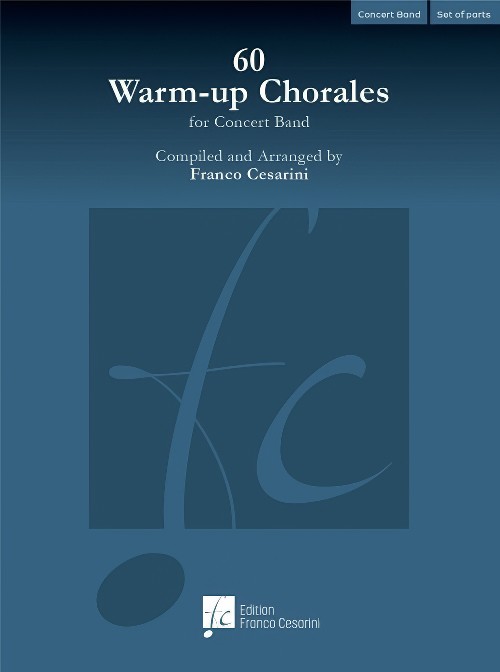 £175.00
£175.0060 Warm-Up Chorales (Concert Band - Score and Parts) - Cesarini, Franco
During his experience as a band conductor and teacher of wind orchestra conducting at university, Franco Cesarini has dealt with the topic of warm-ups very frequently. Throughout these long years of conducting he has had the opportunity to try many existing methods, evaluating their advantages and disadvantages. After a long time, he has decided to compile a collection of chorales for warm-ups, which are organised according to the criteria that he considers most effective. While working on his60 Warm-up Chorales for Concert Band, Franco Cesarini has always borne in mind that amateur musicians play for pleasure. He feels that it is extremely important that they have satisfaction at every moment of the rehearsal and not to start the rehearsal with needless "punishing" exercises. Nobody is really motivated to start playing with scales, long notes, or tricky rhythmical exercises. There is often a distinguished absentee in band rehearsals, namely music itself! Although this publication does not foresee a specific tempo for the chorales, they should often be performed rather slowly but without dragging. Dynamics are not indicated, so that the conductor has the opportunity to draw the attention of the musicians to his gestures and to make them react according to his indications. Timpani and bell parts have been added with the aim of not leaving the percussionists completely inactive during the warm-up phase, but can also be omitted. The chorales are written in four parts (SATB) and are also playable in smaller groups. The four voices can be played in different combinations of woodwinds or brass quartets or in mixed combinations. The collection includes ten chorales for the following keys: D flat major, A flat major, E flat major, B flat major, F major and C major. With his 60 Warm-up Chorales Franco Cesarini would like to convey the message to play the chorales in a musical way, thus raising the musicians' awareness of phrasing, the right interpretation of cadences, rubato and agogic. Above all, never do anything without putting the musical aspect in the foreground. 60 Warm-up Chorales for Concert Band: A perfect collection to warm-up and improve tuning of a concert band!
Estimated dispatch 7-14 working days
-
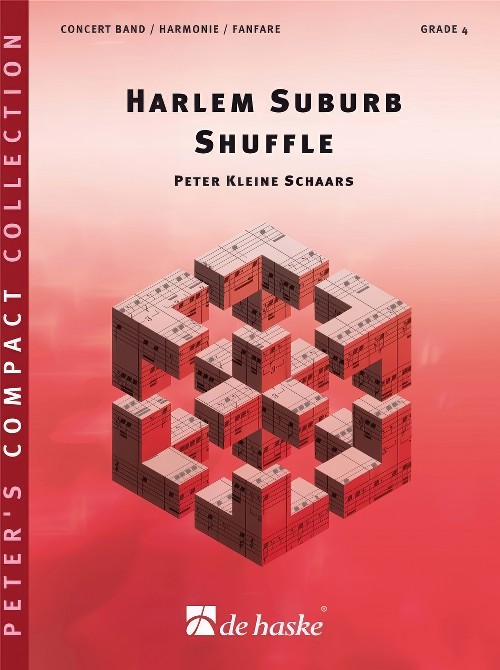 £72.99
£72.99Harlem Suburb Shuffle (Flexible Ensemble - Score and Parts) - Schaars, Peter Kleine
From the beginning of the Middle Ages, we have known performance practices in which the duration of the notes can differ from the actual notation. In some cases, binary written melodies were performed in a ternary way. This is also the case in the present-day shuffle: the written quavers are performed in a long-short system in which the ratio is 2:1. In other words, the performance practice is based on a triplet feel. In this composition, all ingredients of the shuffle are featured: a vigorous swing rhythm, a walking bass, the successions of thirds in the accompaniment and the frequent use of triplets. To make sure that the binary written rhythms in the accompaniments are performed in the correct ternary manner, Peter Kleine Schaars has notated the melody themes in triplets as much as possible. Thus, this composition is a very useful exercise for the swing development of your ensemble. Additionally, the work is a treat to listen to, so your audience will really appreciate this up-tempo big band like composition. All ternary rhythmic cells 17 till 24 pass in revue, further more much attention had been paid to a correct performance of cell 4 in swing feel.Duration: 3.00
Estimated dispatch 7-14 working days
-
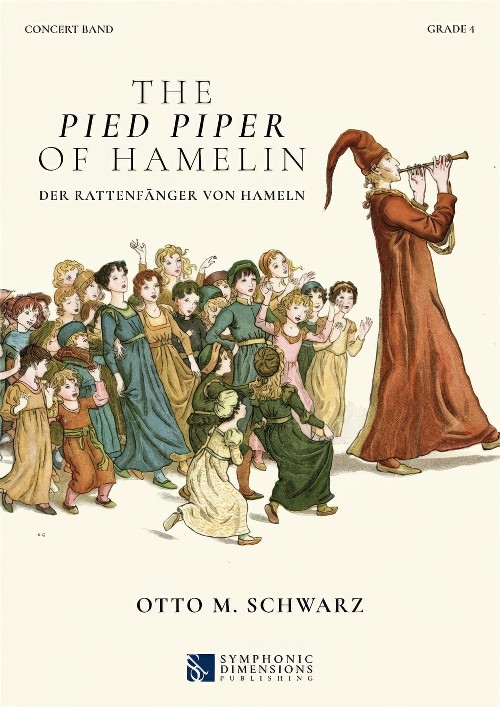 £163.99
£163.99The Pied Piper of Hamelin (Concert Band - Score and Parts) - Schwarz, Otto M.
Stories, sagas and legends--who among us don't know them? Always delivered with a tinge of brutality, these cautionary tales are a legacy of moral education from times past: inquisitive children alone in the forest are generally eaten by a witch; the 'Soup-Kasper' of Hoffmann's Struwwelpeter dies from starvation rather than eating his soup; anyone letting in strangers usually gets devoured; anyone who plays with matches gets burned; and thumb-suckers get their thumbs cut off. The list of unfortunate demises is almost endless.In the tale of The Pied Piper of Hamelin, parents lose their children through greed, ridicule, scorn and a failure to appreciate art. There is still a street in the town of Hamelin in which neither drumming nor playing has not been allowed since 130 children disappeared into a mountain, never to be seen again. This composition by Otto M. Schwarz opens with exactly this scene, taking us back to the year 1284. As in many towns at the time, Hamelin in Germany suffered with hygiene problems--rats and mice began to multiply rapidly, and the town was overrun with the plague. There appeared a man dressed in colourful clothes who promised the locals to free them from this burden. They agreed and settled on a fee. Then the man pulled out a pipe and began to play. When the rats and mice heard this, they followed him. He led the animals into the Weser River, where they all drowned. Back in town, the people refused to pay him. They didn't recognise this man's skills and knowledge and were only prepared to pay for simple labour. A pact with the devil was made, which led to the Pied Piper leaving the town in a furious rage. One Sunday, when many people were at church, he returned, took out his flute and began to play. The town's children were so enchanted by his playing that they followed him. He led them out of the town and disappeared with them forever into a mountain forever. Of all the children, only two survived--however one was mute, and one was blind. In the street from which the children left Hamelin, music may no longer be played in memory of this event. The work may be performed in two different versions: 1. Purely instrumental (without narrator)--the GPs (pauses) must be kept short 2. With narrator--he speaks in the GPs but not during the music.Duration: 14.15
Estimated dispatch 7-14 working days
-
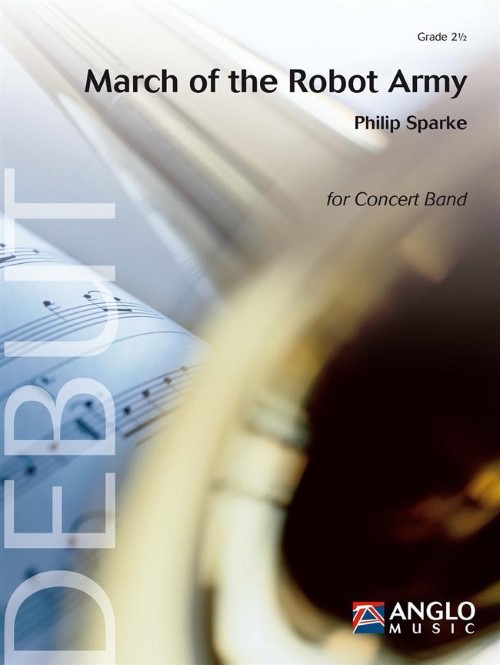 £99.99
£99.99March of the Robot Army (Concert Band - Score and Parts) - Sparke, Philip
March of the Robot Army was commissioned by Linda Anzolin and Giordano-Bruno Tedeschi for Campobanda 2019, with funds made available by Just Italia. Campobanda is an Italian summer music camp for 8 to 18 year olds which has a different theme every year. The theme for 2019 was science fiction, so composer Philip Sparke chose to write a robot march. After a quirky introduction featuring trumpet calls and chromatic figures, the main theme appears in a minor mode on clarinet and tenor sax and is then taken up by the full band. A change of key heralds a new theme, led by the trumpet and again repeated by the full ensemble. A further change of key introduces a legato trio melody over a rather robotic accompaniment: instruments are added bit by bit until a climax is reached. Small motifs from the introduction then lead back to a full recapitulation, revisiting the first two themes in new guises before finishing the march with a flourish.Duration: 5.00
Estimated dispatch 7-14 working days
-
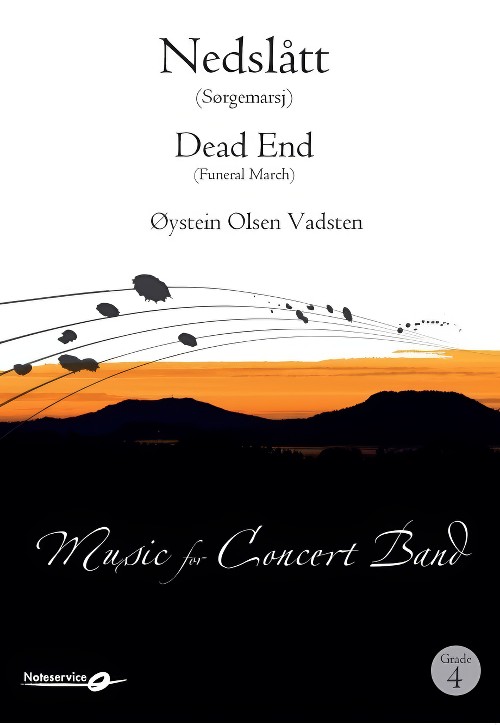 £91.00
£91.00Nedslatt, Sorgemarsj (Dead End, Funeral March) (Concert Band - Score and Parts) - Olsen Vadsten, Oystein
An addition to the composer's series of folk music inspired pieces, has the slightly condescending title "Dead End". The piece is a funeral march and so also written for an occasion, where this style of music was a natural inspiration. It is built on a drum ostinato, which is followed by a melody in Norwegian folk music style. The repetitions in the melody line and rhythm, create a hypnotic effect, leaving us in a special state of mind, alternating between deep sorrow, bottomless despair and grateful gratitude. The piece has proven to be effective, both as a concert opener and as the last piece in a concert. Duration: 6.10
Estimated dispatch 7-14 working days
-
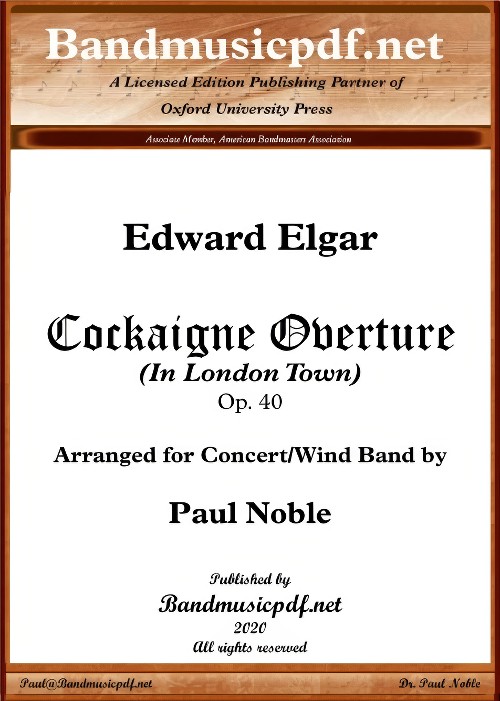 £150.00
£150.00Cockaigne Overture (In London Town) (Concert Band - Score and Parts) - Elgar, Edward - Noble, Paul
Cockaigne Overture was composed when Edward Elgar received a commission from the Royal Philharmonic Society, and he reported that the new piece was "cheerful and Londony, 'stout and steaky'...honest, healthy, humorous and strong, but not vulgar." The first performance was in the Queen's Hall, London, on 20 June 1901, conducted by the composer. He dedicated the work to his "many friends, the members of British orchestras." The music was an immediate success and became one of Elgar's most popular works. In its 15 minutes or so, the overture gives a lively and colourful musical portrait of Edwardian London. 'Cockaigne' was a term used by moralists at that time as a metaphor for gluttony and drunkenness, while Britain adopted the name humorously for London, and from it we get the Cockney. Cockaigne or Cockayne /ka' kein/, the word origin tracing back to the 13th century, is a land of plenty in medieval myth, an imaginary place of extreme luxury and ease where physical comforts and pleasures are always immediately at hand and where the harshness of medieval peasant life does not exist. The work presents various aspects of turn-of-the-century London and Londoners. It begins with a quiet but bustling theme which leads into an unbroken sequence of snapshots: the cockneys, the church bells, the romantic couples, a slightly ragged brass band (perhaps the Salvation Army) and a contrastingly grand and imperious military band. The broad theme representing Londoners has been stated as the first occurrence of Elgar's trademark direction, 'nobilmente.' The work ends in a characteristically Elgarian blaze of sound, including an optional full organ.
Estimated dispatch 7-14 working days
-
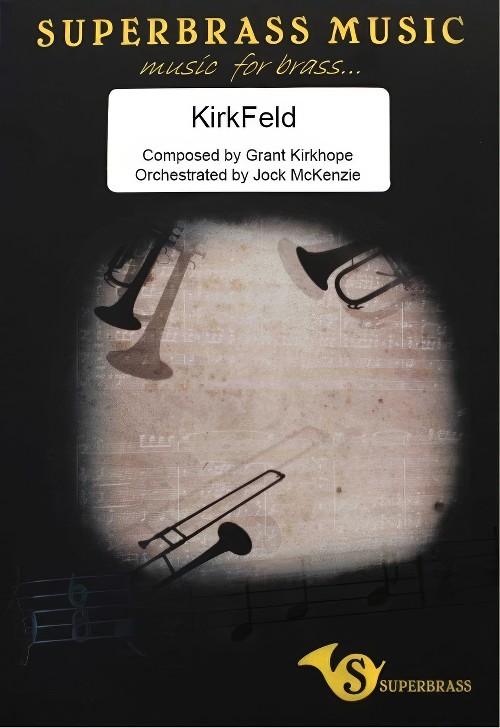 £125.00
£125.00KirkFeld (Trombone Solo with Concert Band - Score and Parts) - Kirkhope, Grant - McKenzie, Jock
Written for Ian Bousfield and the International Trombone Festival 2017. Grant Kirkhope is a BAFTA nominated British composer who has created the soundtrack for video games that have sold in excess of 30 million copies. From "GoldenEye" to "Banjo-Kazooie", "Viva Pi?ata" to "Donkey Kong", "Kingdoms of Amalur: Reckoning" to "Civilization: Beyond Earth" and "Perfect Dark" to "Castle of Illusion starring Mickey Mouse". He has also recently scored the feature film "The King's Daughter" starring Pierce Brosnan and William Hurt and is currently working on "Yooka Laylee" and "Dropzone". Grant's score for "Viva Pi?ata" was nominated by BAFTA in the Original Score category in its 2007 awards. Grant is represented by the prestigious Gorfaine/Schwartz Agency by Cheryl Tiano and Kevin Korn. Grant has a degree in music from the Royal Northern College of Music, Manchester, where he majored in classical trumpet, is a green card holder and now lives in Agoura Hills, LA with his wife and two children. "Ian and I first met when we were around 15 years old. We both played in our county orchestra, the North Yorkshire Schools Symphony Orchestra (I was a trumpet player). I think we hit it off straight away, as we were definitely a couple of cheeky kids, if you know what I mean! We both ended up playing in Rowntree Mackintosh Brass Band for a while too which Ian's Dad, Trevor conducted. We bumped into each other again when we both went for the Shell/LSO Scholarship. I got to the area finals in Manchester so I was pretty pleased with myself but then I saw Ian and I knew it was all over! Of course Ian went on to win and the rest is history. I saw him again when I was attending the Royal Northern College of Music around 1983 by which time Ian had just got the principal chair at the Halle Orchestra. Then I guess 30 something years went by as we both went about our lives and lost touch. We re-kindled our friendship due to his wife really. She emailed me to say it was Ian's 50th birthday and she was collecting stories from all his friends over the years. After that we got back in touch and then one day on Facebook I got a message from him in typical dry Yorkshire fashion "now then Grant, I had a listen to your music and I think it's good, how about writing a piece for me ?" I was a little bit unsure at first but of course I loved Ian's playing and of course I said yes. Over a Skype call in 2016, he asked me what I thought I'd write. I said since I live in LA I'd like to write a "Hollywood" trombone piece. Imagine if John Williams had written a piece for solo trombone, that's what I'd like to write - well I'd certainly like to try" - Grant Kirkhope
Estimated dispatch 7-14 working days
-
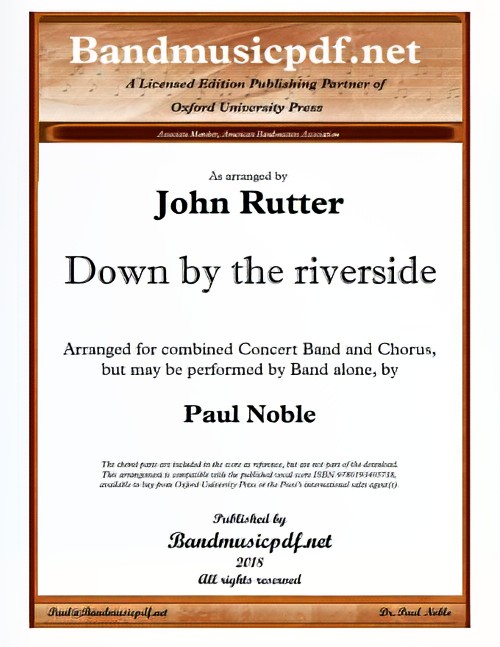 £110.00
£110.00Down by the Riverside (Concert Band with opt. Choir - Score and Parts) - Rutter, John - Noble, Paul
Down by the riverside is a spiritual that was sung by slaves in the South as a work song. It dates back to before the American Civil War. John Rutter's lively arrangement of this barnstorming American folk-song builds up from a quiet opening to a triumphant conclusion. This arrangement is a faithful adaptation of the original orchestration for chorus and orchestra, but it is arranged so that it may be performed by band alone. The style is an authentic toe-tapping early jazz creation that relates to the 'jitterbug' era, and the band arrangement is complete with an optional jazz clarinet solo as well as a rousing chorus by the sax section. The piano part is cued if needed. This is a perfect opportunity to get the entire band 'swinging', and could even entice a 'One mo' time!' finale.
Estimated dispatch 7-14 working days
-
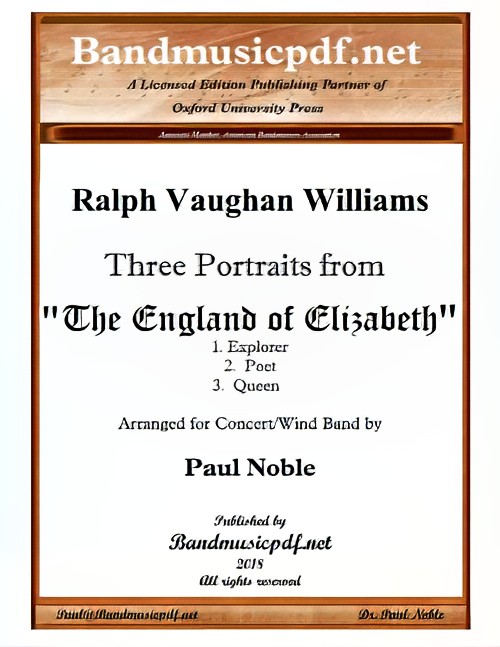 £250.00
£250.00The England of Elizabeth,Three Portraits from (Concert Band - Score and Parts) - Williams, Vaughan - Noble, Paul
This suite was derived from Vaughan Williams' score for the film, The England of Elizabeth, written in 1955. It was the composer's tenth of his 11 cinematic efforts and designed to serve a more descriptive role than other such scores, since the movie was a documentary featuring no action scenes, but lots of images of paintings, buildings, and the like. Composer Muir Matheson adapted this three-movement suite, probably shortly after the composer's death in 1958, though publication of the manuscript would not come until 1964. The first movement is entitled Explorer, and refers to Sir Francis Drake. Its music is mostly festive and colourful, but features interior passages of exotic flavor, similar in style to that of Vaughan Williams' then-recent Symphony No.8. The second movement is entitled Poet and, at about seven minutes, is the longest of the three in this 16 to 17 minute work. It also contains probably the score's best music, hardly a surprising result since the poet in question is Shakespeare, one of the composer's favourites and an inspirational springboard for so many other of his works. The mood is mostly subdued and Vaughan Williams presents lovely, if slightly somber music in the opening, and follows it with a hearty, folk-like dance tune. The latter part of this movement depicts Shakespeare as a noble, heroic figure in English history. The last movement, Queen, is devoted to Queen Elizabeth. It has a regal yet muscular manner at the outset, and features a gentle but somewhat disengaged middle section. It returns to the splendor and colour of the opening to close the work. This suite is important because it distills some of the best music from the film into a logically assembled structure. Program notes extracted from those of Robert Cummings.
Estimated dispatch 7-14 working days
